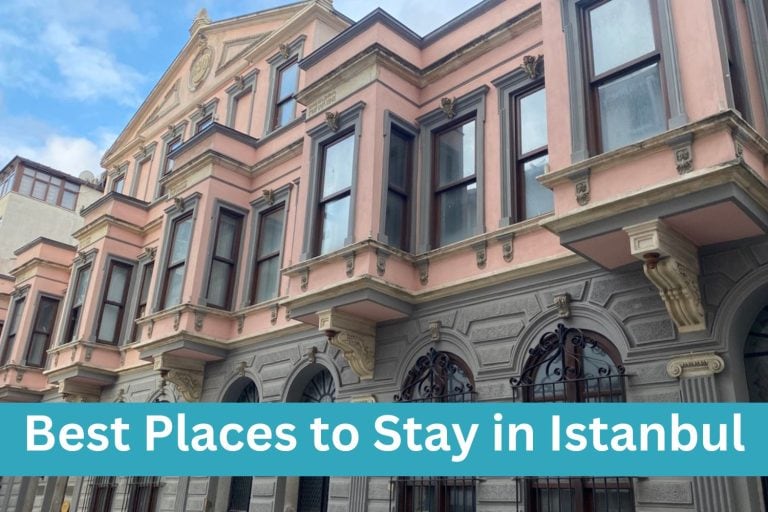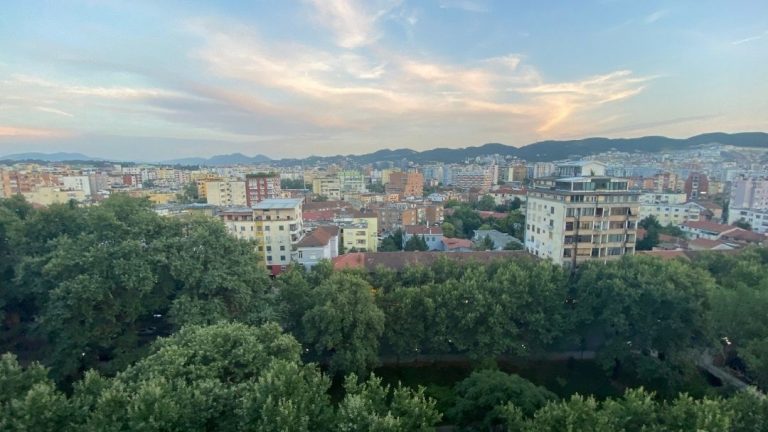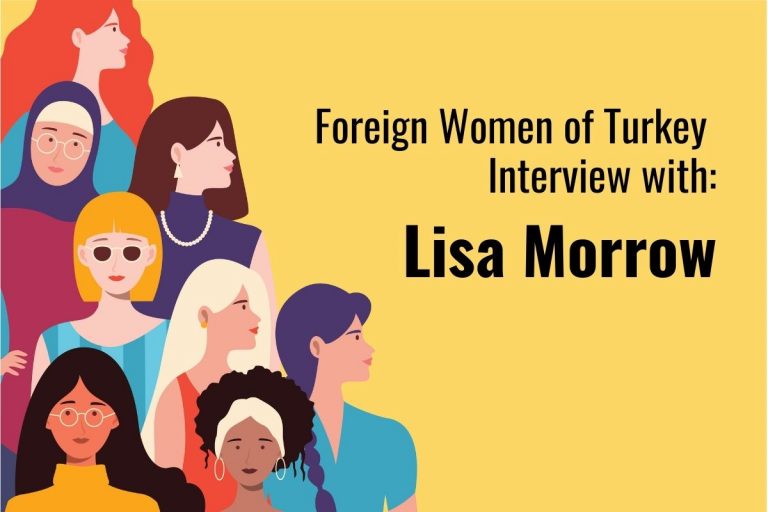Explorer’s Guide: 7 Most Famous Churches Istanbul Has to Offer
The Art of Living in Turkey contains affiliate links and is a member of the Amazon Services LLC Associates Program. If you make a purchase using one of these Amazon links, I may receive compensation at no extra cost to you. See my Disclaimers for more information.
Looking for a list of churches Istanbul has to offer? Here are the 7 you can’t miss.
Istanbul, the city where continents collide, holds within its ancient streets a treasure trove of famous churches.
Each of these sacred structures is a testament to the city’s rich and diverse heritage, showcasing Istanbul’s evolution over the centuries.
In 2022, my husband and I had the privilege of exploring Istanbul for five weeks, immersing ourselves in the bigger-than-life atmosphere that permeates the city.
As we wandered through its ancient streets, we uncovered a treasure trove of famous churches that truly enriched our understanding of Istanbul’s rich heritage.
For travelers seeking a deep dive into Istanbul’s cultural and historical riches, the sheer number of churches can be overwhelming.
Which ones should you visit? What stories do they hold?
The problem lies in unraveling the secrets of these remarkable places of worship, and that’s precisely what I’m here to solve.
During your visit to Istanbul, you’ll also have the opportunity to explore some of the city’s most famous churches.
These religious and architectural wonders are an integral part of Istanbul’s unique charm.
Istanbul today has hundreds of churches and mosques in and around the city.
From Christian and Roman Catholic churches to Eastern Orthodox churches to churches that have been part of a monastery, Istanbul is the city of worship, that is for sure.
Here are some of the best churches and mosques to add to your Istanbul Itinerary.
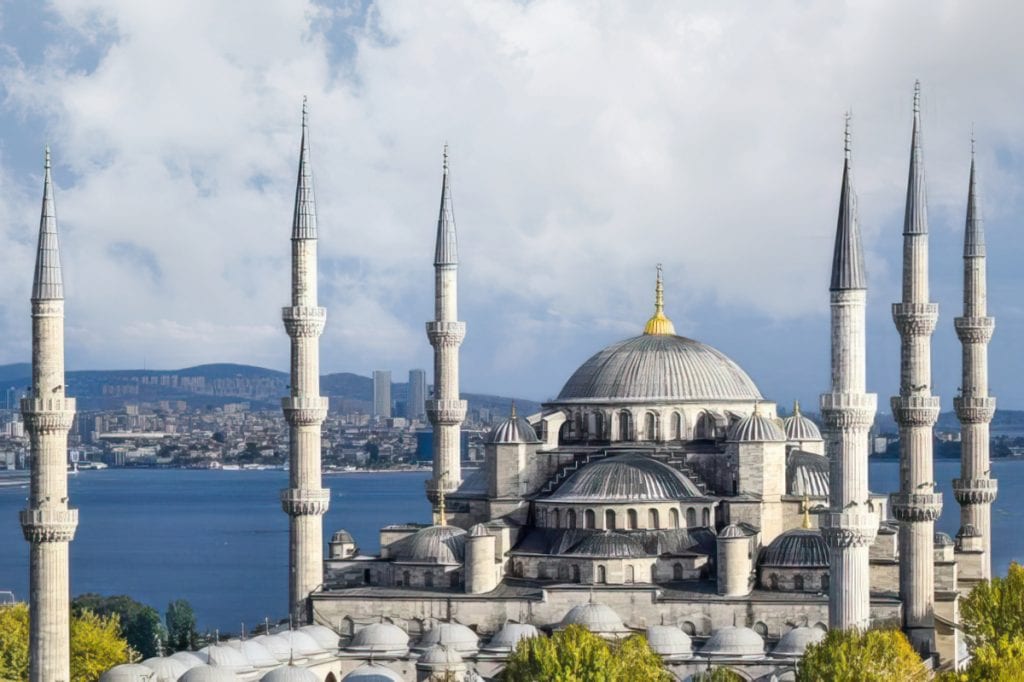
Sultan Ahmed Mosque (The Blue Mosque)
The Sultan Ahmed Mosque, also known as the Blue Mosque, is one of the most iconic landmarks in Istanbul and a must-see for anyone visiting the city.
Its history dates back to the early 1600s when it was commissioned by Sultan Ahmed I.
The mosque was designed by architect Sedefkar Mehmet Ağa and features six minarets and a stunning courtyard. The name “Blue Mosque” comes from the blue tiles that adorn the interior walls.
Sultan Ahmed wasn’t what you would call successful in garnering more territory for Turkey and was well aware of how the people viewed his shortcomings.
The Mosque is said to have been constructed not simply as a long-standing monument to his name but was specifically ordered to be larger and grander than the Hagia Sophia.
The Sultan thought the sheer size and impressive quality of the mosque would impress Allah and once you have visited the mosque I’m sure you will agree: it is one of the most impressive religious structures in the world.
Getting the Best Photos Of The Blue Mosque
To appreciate its stunning architecture, approach the mosque from the Hippodrome side.
This will give you the best view of the building with all its minarets.
Walking through the park from the direction of the Hagia Sophia does showcase the sheer size of the building but walking around the other side will give you the best uninterrupted view of the building.
The interior of the mosque features walls covered in blue tiles, which is where it got its name.
The tiles feature more than 50 tulip designs and there are said to be over 20,000 tiles lining the interior of the mosque.
While the tiles aren’t on the scale of those at the Hassan II Mosque in Casablanca, they are very impressive, especially when you consider their age.
The interior lighting of the mosque isn’t the best for photography so if you are a dedicated photographer I would consider taking a tripod for the best images of the tiles.
Entering The Blue Mosque
Visitors to Istanbul can visit the Sultan Ahmed Mosque during certain times of the day, as it remains an active place of worship.
The mosque is open to visitors every day except during prayer times.
The best time to visit is in the early morning or late afternoon when the light is perfect for photos.
As this is an operating mosque, visitors should be respectful and follow appropriate dress codes, which require that women cover their heads and shoulders and that men wear long pants.
Entry to the Sultan Ahmed Mosque is free, but donations are accepted.
If you don’t have appropriate attire, you can rent scarves and skirts at the entrance of the mosque.
The mosque also offers guided tours for those who want to learn more about its history and significance.
I would highly recommend a guided tour or at least a guide as there is a lot to learn that makes your visit way more enjoyable.
It’s worth noting that the Sultan Ahmed Mosque is one of the busiest tourist attractions in Istanbul, and visitors should expect it to be busy, especially during peak season.
To avoid the crowds, it’s recommended to visit the mosque early in the morning or later in the afternoon.
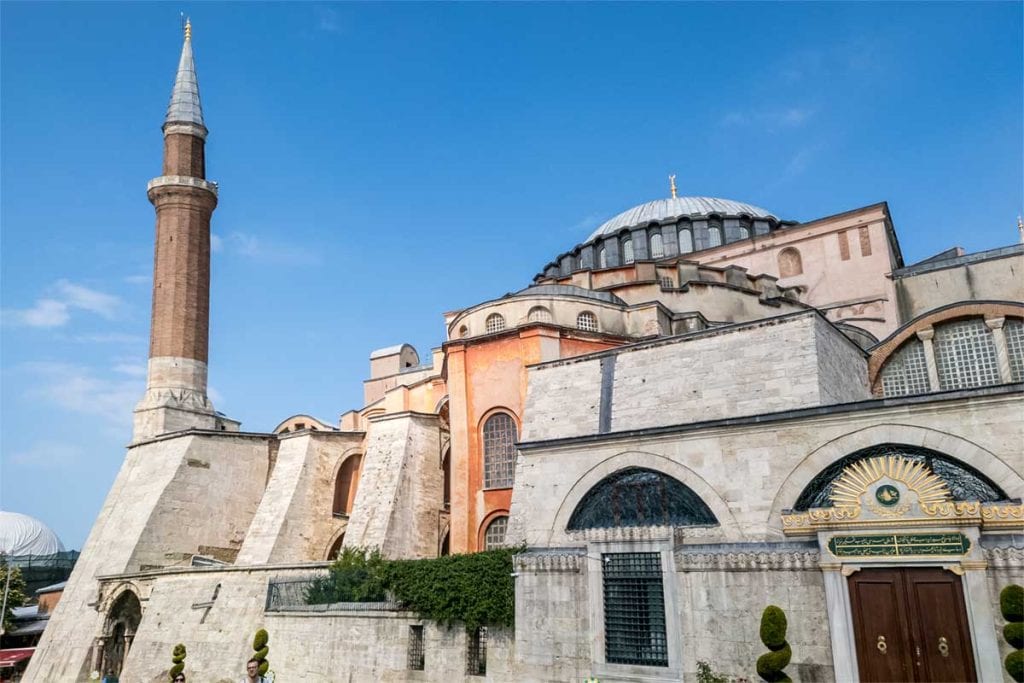
Hagia Sophia Mosque
The Hagia Sophia, also known as the Ayasofya, is one of the most iconic landmarks in Istanbul and a symbol of the city’s rich cultural heritage.
Originally the Hagia Sophia was built as a cathedral in the 6th century. It has also served as a mosque and museum though it is now a mosque once again.
It even served as an Eastern Orthodox Cathedral in Istanbul during the early 1200s.
It is considered the ultimate example of Byzantine Era architecture and is said to have “changed how architecture was perceived”.
After its construction, it remained the world’s largest church for almost a thousand years, only being surpassed by the Cathedral of Seville in the early 1500s.
The original church was built in 360 but it burned twice in its early history and the mosque you see now was constructed in just 6 years, being completed in 537.
There have been some repairs and a full restoration since those times, but for the most part, the church you see now is almost 1500 years old.
It is believed that the designers used more mathematics in the design process than they did actual architectural techniques.
The interior of this Mosque is something to see. Its massive domes, intricate mosaics, and beautiful marble features are truly beautiful.
The interior isn’t as vibrant as some of the other mosques you will visit in Istanbul, but the quality is second to none.
The tones are much more natural however the intricacy of the design is very impressive.
Getting The Best Photos Of The Hagia Sophia
This is one of the busiest tourist sites in all of Turkey.
There are always people inside the mosque so it can be difficult to get photos that showcase the amazing interior.
It is one of the mosques that is also very affected by the time of day with regard to how bright the interior appears.
I visited in the middle of the day and while it is amazing I wasn’t as impressed as I was by other mosques which I considered much more beautiful.
However, a friend visited much later in the day and the light was totally different.
While one side of the interior is in shadow, the alternate side is lit up and the colors are much brighter and the intricacies of the tile and marble appear much clearer in photos.
Entering The Hagia Sophia (Ayasofya Camii)
Visitors to Istanbul can visit the Hagia Sophia Mosque during certain times of the day, as it remains an active place of worship.
As with all mosques you visit in Istanbul, please dress appropriately and cover your head and arms if you are a woman, and be sure to have pants that cover your knees if you are a man.
Entry to the Ayasofya is now free, however, expect to queue, sometimes for hours.
They have a set number of people allowed inside at any particular time so they let people out and then more people in.
We queued for over 2 hours and others we met lined up for up to 4 hours.
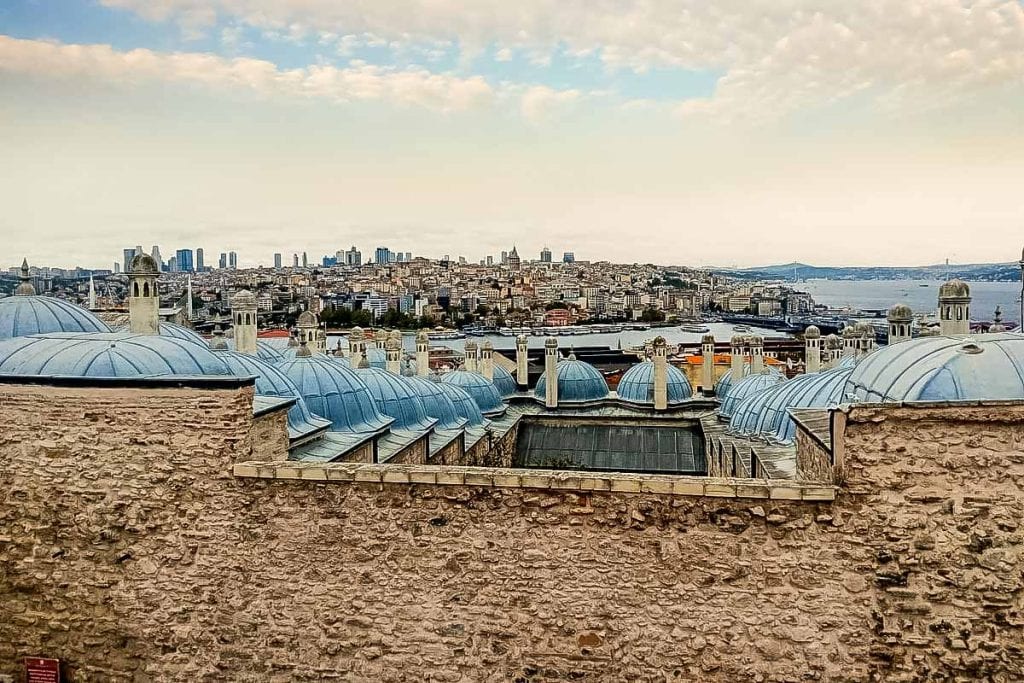
Süleymaniye Mosque
One of Istanbul’s most grandiose mosques, the Suleymaniye was built in the mid-16th century during the reign of Suleiman the Magnificent.
The mosque is known for its towering dome and four minarets, as well as its tranquil courtyard and ornate interior.
It stands as a magnificent testament to Ottoman architectural prowess and as it is located on the Third Hill of Istanbul, it commands a breathtaking panoramic view of the city, overlooking the Golden Horn and the Bosphorus.
Built between 1550 and 1557, the Suleymaniye Mosque has deep historical roots.
It was not only a place of worship but also a symbol of the Empire’s grandeur during the reign of Sultan Suleiman.
Beyond its architectural splendor, the mosque complex holds the tombs of Suleiman the Magnificent and his beloved wife, Hurrem Sultan (Roxelana), adding an additional layer of historical significance.
The interior of the Suleymaniye Mosque is beautiful. Its high ceilings, intricate tilework, and beautiful calligraphy create a truly awe-inspiring atmosphere.
The hanging chandeliers are both simple and incredible.
The interior is more subtle than the Hagia Sophia for example but the mosaics and coloured ceilings are cleaner and still beautiful.
The complex also includes a library, a hospital, a school, and a kitchen, showcasing the holistic approach of Ottoman architecture to community needs.
Because of its location in Eminönü, a short walk from the main tourist area in Istanbul, there are usually way fewer visitors and you can get inside fairly quickly.
Entering Suleymaniye Mosque
Suleymaniye Mosque is open from 9 am to 6 pm daily. Visitors are welcome between these hours with the exception being for an hour on either side of prayers.
Finding the entry can be a little tricky but just stop and ask the locals and they will be happy to point you in the right direction.
I wasn’t able to find any facilities for loaning scarves or long skirts here so be sure to be dressed appropriately.
Entry to the Suleymaniye Mosque is free, but donations are accepted.
Why Visit the Suleymaniye Mosque in Istanbul?
Visitors to Istanbul should make the Suleymaniye Mosque a priority on their itinerary for several compelling reasons.
Firstly, it offers a serene escape from the city’s hustle and bustle, providing a tranquil space for reflection and contemplation.
Personally, I really felt like I was inside a religious building here.
Secondly, the panoramic views from its courtyard are simply breathtaking, making it a prime spot for capturing stunning photographs of Istanbul’s skyline.
Finally, the mosque is a place where spirituality, history, and architecture converge, making it a must-visit destination in this vibrant city.
While the mosques in Istanbul are all different they have a very similar style and I found myself comparing them to each other like I did when I visited the Rock Hewn Churches of Lalibela in Ethiopia.
Even though they are similar in their areas of worship, lighting, and even their windows, the interior fit-out is what usually sets them apart.
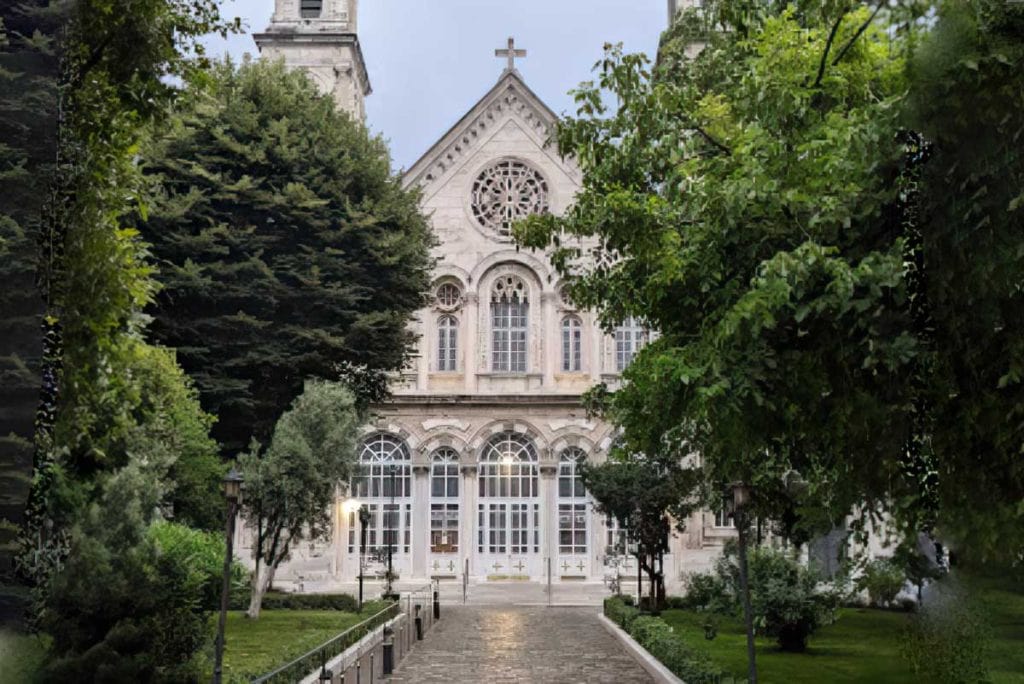
Hagia Triada Greek Orthodox Church
Hagia Triada Greek Orthodox Church in Istanbul, also known as the Holy Trinity Church, is one of the most historically significant churches of Istanbul.
It is also considered the largest Greek Orthodox shrine in Istanbul today.
Originally constructed in the late 19th century to serve the city’s Greek Orthodox community, the church was designed by renowned architect P. Argyriadis.
It features a stunning mix of Byzantine and neoclassical architectural styles, making it one of the most interesting churches in Istanbul today.
Visitors are welcome to explore the church’s stunning interior, which features beautiful frescoes and intricate mosaics.
The church’s courtyard is also worth exploring, as it offers a peaceful retreat from the bustling city.
The interior is very elaborate with smooth marble floors, golden chandeliers, and as mentioned, very intricate mosaics mostly featuring Jesus.
It’s worth noting that the Hagia Triada Church is not as well-known as some of Istanbul’s other historic landmarks, and visitors can expect a quieter and more relaxed atmosphere.
The church is a perfect place to escape the crowds and take a moment to appreciate Istanbul’s rich cultural heritage.
What I noticed most here is that the front facade of the church is very different from the rear one.
Make sure you walk around the church perimeter to see the difference between the elegant street front entry and the blockish solid rear section.
You would be hard-pressed to pick it as the same building.
Entering Hagia Triada Church
The church on the corner of Istiklal Street in Taksim District, a short walk from Taksim Square, is open to visitors every day except on Mondays and Tuesdays.
It can be a little unreliable with opening times, however, if you don’t have any success just come back at the end of a mass time to get in.
Entry to the Hagia Triada Church is free and is a must-visit attraction for anyone interested in Istanbul’s diverse cultural heritage.
If you have visited some of the mosques before you make it to Hagia Triada the difference between the mosques and the churches is very clear.
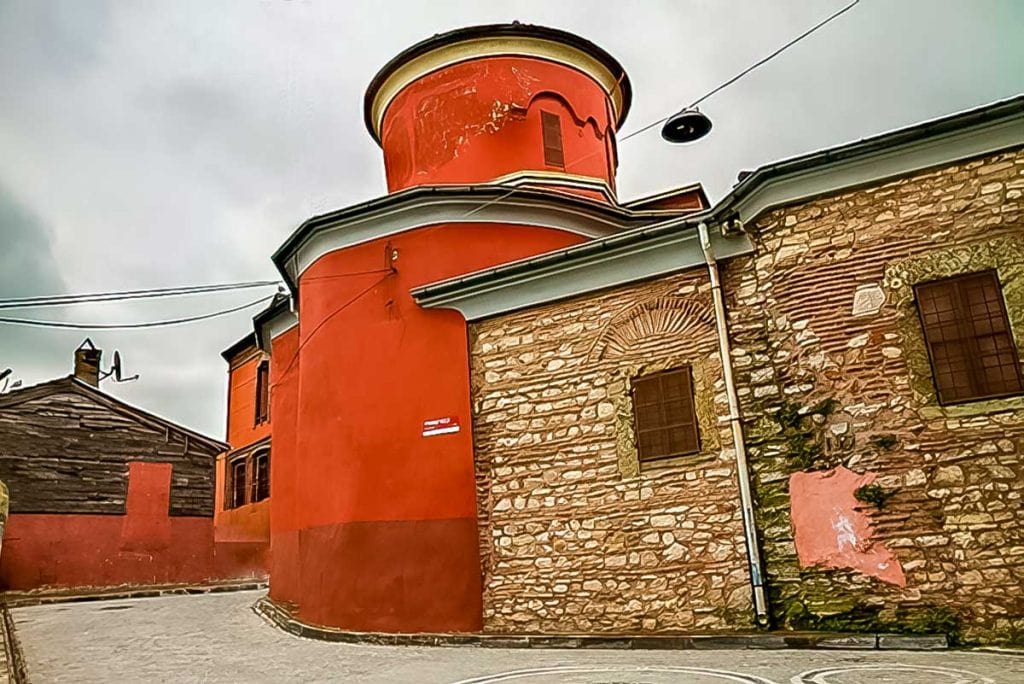
The Church of Our Lady of the Mongols (Bloody Church)
The Church of Our Lady of the Mongols, also known as the Bloody Church, is a church located in the Balat district of Istanbul with a long and varied history.
It was originally built in the 13th century to serve the city’s Mongol community, who were invited to Istanbul by the Ottomans as allies.
The church is known for the bloody massacres that took place within its walls during the Ottoman Empire.
The current building and church are one of the few that were not converted into a mosque during the Byzantine period.
The interior of the Church of Our Lady of the Mongols features beautiful frescoes and intricate mosaics.
Its history as a site of violence and bloodshed during the Ottoman Empire is a reminder of the city’s complex and often tragic past.
Today, the Church of Our Lady of the Mongols is a peaceful and historic site that is open to visitors.
The church is located on a narrow street in the Balat district and can be reached by foot or by taxi. Visitors should be aware that this area of Istanbul is hilly and may require some walking.
Visitors of all faiths are welcome to visit the Church of Our Lady of the Mongols.
Entering The Church Of St. Mary of Mongols
The church is open to visitors however it is behind a very high wall and you do need to ring the small bell near the sign that says “Meryem Ana Rum Ortodoks Kilesesi” for entry.
Be aware that the church itself is only very small and the main building you see is actually the more famous Phanar Greek Orthodox College.
As a site of both violence and peace, the Church of Our Lady of the Mongols is a reminder of the complexity of Istanbul’s history and culture.
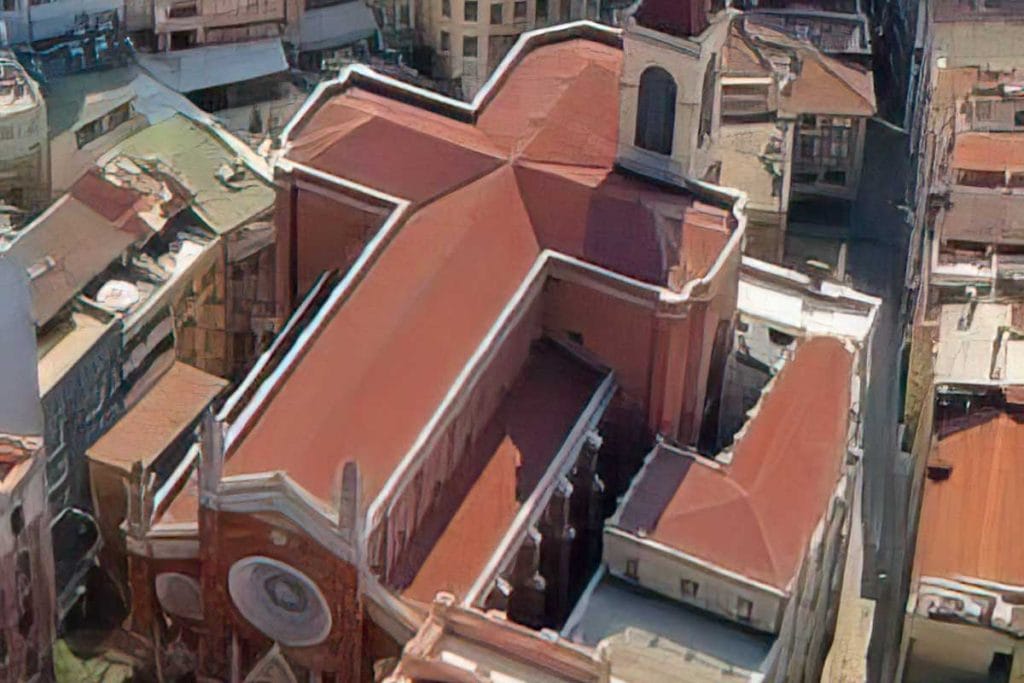
Saint Antoine (St. Anthony of Padua) Catholic Church
Saint Antoine Catholic Church, also known as St. Anthony of Padua Church, is a beautiful and historic church located in the Beyoğlu district of Istanbul.
It was built in the late 19th century to serve the city’s Catholic community, many of whom were Italian merchants and diplomats.
The church was designed by Italian architect Giulio Mongeri and features a stunning mix of neoclassical and baroque architectural styles.
The church is relatively small compared to some of Istanbul’s other historic landmarks, but it is no less impressive.
It is constructed using a mix of marble and stone, with beautiful stained glass windows and ornate carvings throughout the interior.
The church’s bell tower is a notable feature of its architecture, and visitors can climb to the top for a stunning view of the city.
The Church is notable locally for 2 things:
Firstly their Christmas display, particularly their annual nativity scene is something you don’t often see around Istanbul and is very popular with the local catholics.
Secondly, Pope John XXIII served here for 10 years while he was the ambassador to Turkey for the Vatican. This is the reason he is referred to as the “Turkish Pope”.
The local Istanbul community benefited greatly from his love of not just Turkey but Istanbul in particular. There is a statue of him in the church’s courtyard.
The church has a unique view from above as well as the shape of the building is a Christian cross.
Visitors to Istanbul can visit the Church of Saint Antoine and are welcome to experience mass.
Mass Times At St Anthony’s of Padua
The church runs mass in English, Polish, Turkish, and Italian. Times are listed below:
| English Mass | Italian Mass | Turkish Mass | Polish Mass |
| Weekdays 7 pm & Tuesdays 11 am | |||
| Weekdays 8 am | Sunday 11:30 am | Saturday 7 pm | Sunday 11:30 am (Crypt) |
| Weekdays 8am | Sunday 10 am |
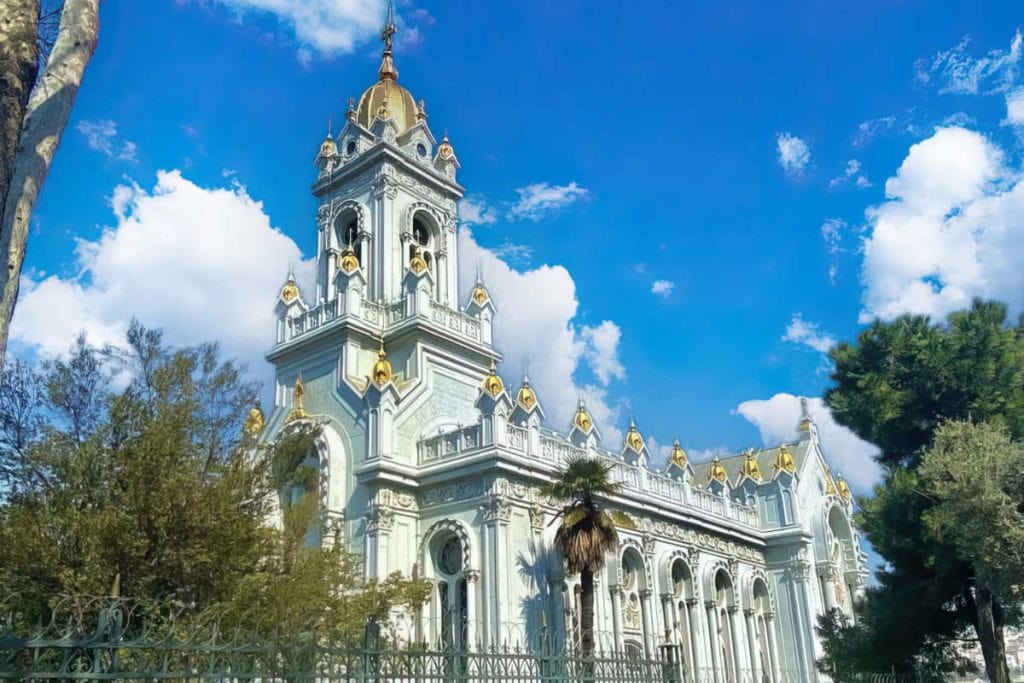
The Bulgarian Church (Church of Sveti Stefan)
The Bulgarian Church, also known as the Church of St. Stephen, is a beautiful and historic church located in the Fatih district of Istanbul.
This church was built in the late 19th century to serve the city’s Bulgarian Orthodox community, many of whom were merchants and traders.
Originally a timber building that, like so many others of the time, succumbed to fire, was rebuilt in its current form in the late 1800s.
The church was designed by renowned architect Hovsep Aznavur and features a stunning mix of Byzantine and neoclassical architectural styles.
Today, it’s the only iron church that remains.
The ground was considered not stable enough to support a concrete-only building so the iron frame was created to ensure the church would stand for years to come.
It was one of the first prefabricated buildings to be erected in Istanbul with the iron components put out to tender.
An Austrian company won the tender and the components were manufactured in Vienna over 3 years.
The 500 tonnes of prefab elements were shipped through the Danube and the Black Sea to Istanbul.
The building was assembled using a variety of techniques including welding, rivets, screws, & nuts and bolts.
The white exterior is set off by the multiple golden caps edging the roof. The huge golden dome over the entrance of the church is just beautiful.
Restored over 7 years before reopening in 2018, this was one of my favorite churches in Istanbul.
The inside is almost overwhelming in its grandeur and gold is definitely the word of the day!
Entering The Bulgarian Iron Church of Istanbul
Entry to the Bulgarian Church is free, and visitors are welcome to explore the church’s stunning exterior, interior, and grounds.
The church is open to visitors every day however they do ask you to avoid coming to the church on Sunday during mass times, which is when the Bulgarian minority community worships here.
What should I wear to visit the churches and mosques
Mosques in particular have very strict dress codes.
For women, heads must be covered with scarves, and shoulders and knees should also be covered. While mid-calf length skirts are OK, if you can wear something longer that would be preferred.
For Men, please cover your shoulders and knees.
Christian churches in Istanbul also would appreciate appropriate dress.
While it’s not necessary to cover your head, please be respectful and wear loose-appropriate clothing. Short shorts, skimpy tops, and anything too revealing should be avoided.
Frequently Asked Questions About the best churches in Istanbul
Can non-Muslims visit the mosques of Istanbul?
Yes, you are welcome to visit as a non-Muslim, however, please do not enter during prayer times. The call to prayer can’t be missed so if you find yourself inside a mosque and you hear the call, please leave and return after prayers have finished.
When is prayer time for the Mosques?
Do I need to wash my feet before entering a mosque?
No, you do not. The purification ritual (called Wudu) is used before prayer and is not necessary just to enter a mosque. You will need to remove your shoes and leave them at the entrance in the rack provided.
Are there any Armenian Churches in Istanbul, Turkey?
Yes, there are 28 active Armenian Istanbul Churches with six of those being on the Anatolian side.
What is the oldest church in Istanbul?
Hagia Sophia, though not currently a church, was built as a church in the 500s, making it not only the oldest building in Istanbul but also the oldest church in Istanbul.
* Prayer Times
| Winter Prayer Times | Summer Prayer Times |
| Dawn: 06.30-07.30 | Dawn: 05.50-06.40 |
| Midday: – 11.50-12.50 | Midday: 13.00-14:00 |
| Afternoon: – 14.30-16.30 | Afternoon: 16.15-17.00 |
| Sunset: – 16.30-19.30 | Sunset (or evening prayer): 19.00-20.40 |
| Night: – 18.30-21.00 | Night: 20.30-22.30 |
Interactive map of Churches Istanbul has to offer:
Final thoughts on Churches you should see when you visit Istanbul
We talked about 7 of the most beautiful churches to see on your next trip to Istanbul but that is just the beginning. There are so many more than that!
Istanbul’s churches are a testament to the city’s rich and diverse history.
From the Hagia Sophia’s breathtaking dome to the unique iron construction of the Bulgarian church, these churches offer a glimpse into the city’s Byzantine, Ottoman, as well as modern eras.
Whether you’re interested in art, architecture, or religion, these churches are sure to leave you with lasting memories.
When you visit any of them you are welcome to have a look around, sit and take it all in, or even pray at the churches.
One more you should check out when it re-opens is the Chora Mosque (Kariye Camii) known for its incredible frescoes. It was originally a church but has recently been converted to a mosque.
There are also Protestant churches in Istanbul but since they are newer, they have neither the same history nor the epic buildings of the older churches.
Hope you found some new places to add to your itinerary while in Turkey.
Written by: Jenny from Charge The Globe. She has visited 103 countries over 30 years. Jenny has a wealth of knowledge to share with her readers about the cultures, landscapes, and people she has encountered on her journeys. She’s always battling unfashionably frizzy hair, and you will never catch Jenny in anything but comfortable shoes.
Read more:
- Learn a bit of Turkish before you come and make life easier
- Wanna learn about the food culture as well? Try one of these food tours
- Get out of Istanbul with these 11 single-day trips
- Don’t forget to get your SIM card for your trip to Istanbul
- Considering living in Istanbul? Check out the cost of living
Turkey Vacation Basics
When I plan a trip these are the websites I use. Hope they help you plan your next adventure as well!
FLIGHTS: I am a huge fan of Skyscanner and WayAway.
VISAS: You can use the free e-visa portal here but for a few extra dollars you can use iVisa and someone else will handle any issues that may come up.
E-SIM: When I traveled to SE Asia I discovered e-sims and I’m never going back. Airalo has been easy and cheap!
TRAVEL INSURANCE: I use TravelInsurance.com for my trips abroad.
CAR RENTAL: I have loved working with Discover Cars when I rent cars in country.
AIRPORT TRANSFERS: I have used these transfers many times and they are always great. If you’d like more options, I also recommend GetTransfers.com as they allow you to compare companies.
ACCOMMODATION: Find the best Turkey hotel deals on Booking.com.
CITY TOURS & DAY TRIPS: You can browse GetYourGuide’s website to find just the tour you’re looking for!
